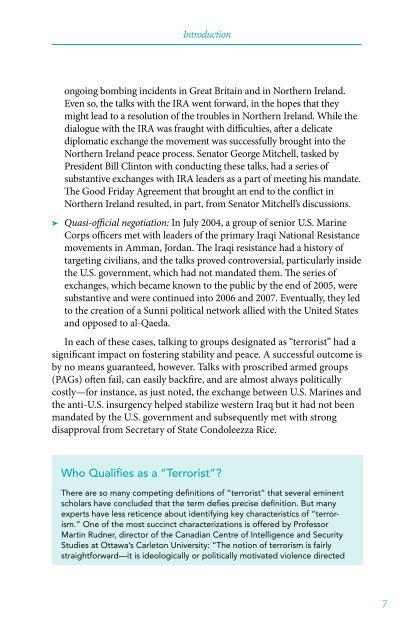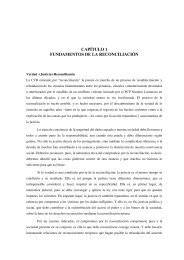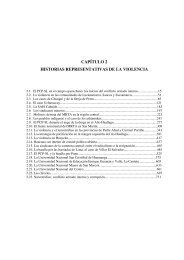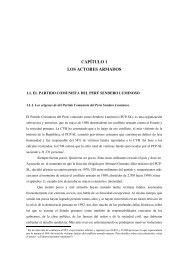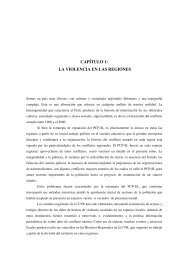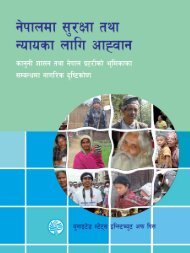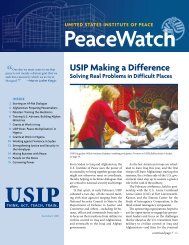Talking to Groups that Use Terror.pdf - United States Institute of Peace
Talking to Groups that Use Terror.pdf - United States Institute of Peace
Talking to Groups that Use Terror.pdf - United States Institute of Peace
You also want an ePaper? Increase the reach of your titles
YUMPU automatically turns print PDFs into web optimized ePapers that Google loves.
Introductionongoing bombing incidents in Great Britain and in Northern Ireland.Even so, the talks with the IRA went forward, in the hopes <strong>that</strong> theymight lead <strong>to</strong> a resolution <strong>of</strong> the troubles in Northern Ireland. While thedialogue with the IRA was fraught with difficulties, after a delicatediplomatic exchange the movement was successfully brought in<strong>to</strong> theNorthern Ireland peace process. Sena<strong>to</strong>r George Mitchell, tasked byPresident Bill Clin<strong>to</strong>n with conducting these talks, had a series <strong>of</strong>substantive exchanges with IRA leaders as a part <strong>of</strong> meeting his mandate.The Good Friday Agreement <strong>that</strong> brought an end <strong>to</strong> the conflict inNorthern Ireland resulted, in part, from Sena<strong>to</strong>r Mitchell’s discussions.➤ ➤ Quasi-<strong>of</strong>ficial negotiation: In July 2004, a group <strong>of</strong> senior U.S. MarineCorps <strong>of</strong>ficers met with leaders <strong>of</strong> the primary Iraqi National Resistancemovements in Amman, Jordan. The Iraqi resistance had a his<strong>to</strong>ry <strong>of</strong>targeting civilians, and the talks proved controversial, particularly insidethe U.S. government, which had not mandated them. The series <strong>of</strong>exchanges, which became known <strong>to</strong> the public by the end <strong>of</strong> 2005, weresubstantive and were continued in<strong>to</strong> 2006 and 2007. Eventually, they led<strong>to</strong> the creation <strong>of</strong> a Sunni political network allied with the <strong>United</strong> <strong>States</strong>and opposed <strong>to</strong> al-Qaeda.In each <strong>of</strong> these cases, talking <strong>to</strong> groups designated as “terrorist” had asignificant impact on fostering stability and peace. A successful outcome isby no means guaranteed, however. Talks with proscribed armed groups(PAGs) <strong>of</strong>ten fail, can easily backfire, and are almost always politicallycostly—for instance, as just noted, the exchange between U.S. Marines andthe anti-U.S. insurgency helped stabilize western Iraq but it had not beenmandated by the U.S. government and subsequently met with strongdisapproval from Secretary <strong>of</strong> State Condoleezza Rice.Who Qualifies as a “<strong>Terror</strong>ist”?There are so many competing definitions <strong>of</strong> “terrorist” <strong>that</strong> several eminentscholars have concluded <strong>that</strong> the term defies precise definition. But manyexperts have less reticence about identifying key characteristics <strong>of</strong> “terrorism.”One <strong>of</strong> the most succinct characterizations is <strong>of</strong>fered by Pr<strong>of</strong>essorMartin Rudner, direc<strong>to</strong>r <strong>of</strong> the Canadian Centre <strong>of</strong> Intelligence and SecurityStudies at Ottawa’s Carle<strong>to</strong>n University: “The notion <strong>of</strong> terrorism is fairlystraightforward—it is ideologically or politically motivated violence directed7


